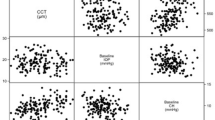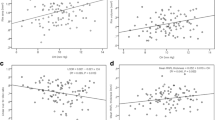Abstract
Background
Corneal hysteresis (CH) has been associated with visual field damage in glaucoma and is related to the velocity of perimetric glaucoma progression. We undertook this investigation to determine whether CH is associated with structural markers of glaucoma damage on spectral domain optical coherence tomography (SD-OCT).
Methods
In this retrospective study, 131 patients under glaucoma evaluation were evaluated with SD-OCT (Cirrus; Carl Zeiss Meditec, Dublin, CA) and had CH measurements with the ocular response analyzer (Reichert, Inc., Buffalo, NY). Pearson and partial correlation adjusting for age were preformed to examine the association between CH and variables of interest. Generalized estimating equations were used to construct simple and multiple linear models.
Results
While Pearson correlations were modest overall, CH best correlated with mean deviation (MD; r = 0.19) followed by average retinal nerve fiber layer (RNFL) thickness (r = 0.18) and vertical cup to disc ratio (r = −0.11) in the open angle glaucoma group. In univariable models, CH varied as a function of MD (ß = 0.1, 95 % CI 0.03, 0.1; p < 0.001) and of average RNFL thickness (ß = 0.2, 95 % CI 0.1, 0.4; p = 0.001). In a multivariable analysis including MD, age, average RNFL thickness, and glaucoma status, MD (p = 0.001) and age (p < 0.001) retained significant associations with CH.
Conclusions
In patients under evaluation and treatment for glaucoma, CH was more closely related to visual field MD than to structural markers of glaucoma damage as measured by SD-OCT.


Similar content being viewed by others
References
Congdon NG, Broman AT, Bandeen-Roche K, Grover D, Quigley HA (2006) Central corneal thickness and corneal hysteresis associated with glaucoma damage. Am J Ophthalmol 141:868–875
De Moraes CV, Hill V, Tello C, Liebmann JM, Ritch R (2012) Lower corneal hysteresis is associated with more rapid glaucomatous visual field progression. J Glaucoma 21:209–213
Mangouritsas G, Morphis G, Mourtzoukos S, Feretis E (2009) Association between corneal hysteresis and central corneal thickness in glaucomatous and non-glaucomatous eyes. Acta Ophthalmol 87:901–905
Herndon LW, Weizer JS, Stinnett SS (2004) Central corneal thickness as a risk factor for advanced glaucoma damage. Arch Ophthalmol 122:17–21
Anand A, De Moraes CG, Teng CC, Tello C, Liebmann JM, Ritch R (2010) Corneal hysteresis and visual field asymmetry in open angle glaucoma. Invest Ophthalmol Vis Sci 51:6514–6518
Morita T, Shoji N, Kamiya K, Fujimura F, Shimizu K (2012) Corneal biomechanical properties in normal-tension glaucoma. Acta Ophthalmol 90:e48–e53
Kaushik S, Pandav SS, Banger A, Aggarwal K, Gupta A (2012) Relationship between corneal biomechanical properties, central corneal thickness, and intraocular pressure across the spectrum of glaucoma. Am J Ophthalmol 153:840–849
Cankaya AB, Anayol A, Ozcelik D, Demirdogen E, Yilmazbas P (2012) Ocular response analyzer to assess corneal biomechanical properties in exfoliation syndrome and exfoliative glaucoma. Graefes Arch Clin Exp Ophthalmol 250:255–260
Mwanza JC, Oakley JD, Budenz DL, Anderson DR, Cirrus Optical Coherence Tomography Normative Database Study G (2011) Ability of cirrus HD-OCT optic nerve head parameters to discriminate normal from glaucomatous eyes. Ophthalmology 118:241–248
Sharma A, Oakley JD, Schiffman JC, Budenz DL, Anderson DR (2011) Comparison of automated analysis of Cirrus HD OCT spectral-domain optical coherence tomography with stereo photographs of the optic disc. Ophthalmology 118:1348–1357
Leung CK, Chiu V, Weinreb RN, Liu S, Ye C, Yu M, Cheung CY, Lai G, Lam DS (2011) Evaluation of retinal nerve fiber layer progression in glaucoma: a comparison between spectral-domain and time-domain optical coherence tomography. Ophthalmology 118:1558–1562
Shpak AA, Sevostyanova MK, Ogorodnikova SN, Shormaz IN (2012) Comparison of measurement error of Cirrus HD-OCT and Heidelberg Retina Tomograph 3 in patients with early glaucomatous visual field defect. Graefes Arch Clin Exp Ophthalmol 250:271–277
Mansouri K, Leite MT, Weinreb RN, Tafreshi A, Zangwill LM, Medeiros FA (2012) Association between corneal biomechanical properties and glaucoma severity. Am J Ophthalmol 153:419–427
Ehrlich JR, Haseltine S, Shimmyo M, Radcliffe NM (2010) Evaluation of agreement between intraocular pressure measurements using Goldmann applanation tonometry and Goldmann correlated intraocular pressure by Reichert’s ocular response analyser. Eye 24:1555–1560
Sullivan-Mee M, Katiyar S, Pensyl D, Halverson KD, Qualls C (2012) Relative importance of factors affecting corneal hysteresis measurement. Optom Vis Sci 89:E803–E811
Medeiros FA, Zangwill LM, Bowd C, Mansouri K, Weinreb RN (2012) The structure and function relationship in glaucoma: implications for detection of progression and measurement of rates of change. Invest Ophthalmol Vis Sci 53:6939–6946
Sehi M, Zhang X, Greenfield DS, Chung Y, Wollstein G, Francis BA, Schuman JS, Varma R, Huang D, Advanced Imaging for Glaucoma Study G (2012) Retinal nerve fiber layer atrophy is associated with visual field loss over time in glaucoma suspect and glaucomatous eyes. Am J Ophthalmol. doi:10.1016/j.ajo.2012.07.005
Ramulu P (2009) Glaucoma and disability: which tasks are affected, and at what stage of disease? Curr Opin Ophthalmol 20:92–98
Kotecha A, Elsheikh A, Roberts CR, Zhu H, Garway-Heath DF (2006) Corneal thickness- and age-related biomechanical properties of the cornea measured with the ocular response analyzer. Invest Ophthalmol Vis Sci 47:5337–5347
Kamiya K, Shimizu K, Ohmoto F (2009) Effect of aging on corneal biomechanical parameters using the ocular response analyzer. J Refract Surg 25:888–893
Wells AP, Garway-Heath DF, Poostchi A, Wong T, Chan KC, Sachdev N (2008) Corneal hysteresis but not corneal thickness correlates with optic nerve surface compliance in glaucoma patients. Invest Ophthalmol Vis Sci 49:3262–3268
Bochmann F, Ang GS, Azuara-Blanco A (2008) Lower corneal hysteresis in glaucoma patients with acquired pit of the optic nerve (APON). Graefes Arch Clin Exp Ophthalmol 246:735–738
Lesk MR, Hafez AS, Descovich D (2006) Relationship between central corneal thickness and changes of optic nerve head topography and blood flow after intraocular pressure reduction in open-angle glaucoma and ocular hypertension. Arch Ophthalmol 124:1568–1572
Ehrlich JR, Peterson J, Parlitsis G, Kay KY, Kiss S, Radcliffe NM (2011) Peripapillary choroidal thickness in glaucoma measured with optical coherence tomography. Exp Eye Res 92:189–194
Agarwal DR, Ehrlich JR, Shimmyo M, Radcliffe NM (2012) The relationship between corneal hysteresis and the magnitude of intraocular pressure reduction with topical prostaglandin therapy. Br J Ophthalmol 96:254–257
Haseltine SJ, Pae J, Ehrlich JR, Shammas M, Radcliffe NM (2012) Variation in corneal hysteresis and central corneal thickness among black, hispanic and white subjects. Acta Ophthalmol 90:e626–631
Pensyl D, Sullivan-Mee M, Torres-Monte M, Halverson K, Qualls C (2012) Combining corneal hysteresis with central corneal thickness and intraocular pressure for glaucoma risk assessment. Eye 26:1349–1356
Funding/Support
This study was supported by the Medical Student Training in Aging Research Program, by the Seth Sprague Educational & Charitable Foundation, by Research to Prevent Blindness and by The American Glaucoma Society through the Mentoring for Advancement of Physician-Scientists award program.
Financial disclosure
NMR has received honoraria from Allergan, Alcon, Merck & Co., Inc., Iridex, Carl Zeiss Meditec and Merge Healthcare.
Author information
Authors and Affiliations
Corresponding author
Rights and permissions
About this article
Cite this article
Vu, D.M., Silva, F.Q., Haseltine, S.J. et al. Relationship between corneal hysteresis and optic nerve parameters measured with spectral domain optical coherence tomography. Graefes Arch Clin Exp Ophthalmol 251, 1777–1783 (2013). https://doi.org/10.1007/s00417-013-2311-x
Received:
Revised:
Accepted:
Published:
Issue Date:
DOI: https://doi.org/10.1007/s00417-013-2311-x




